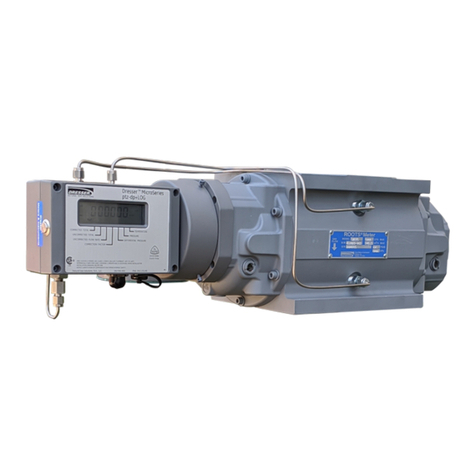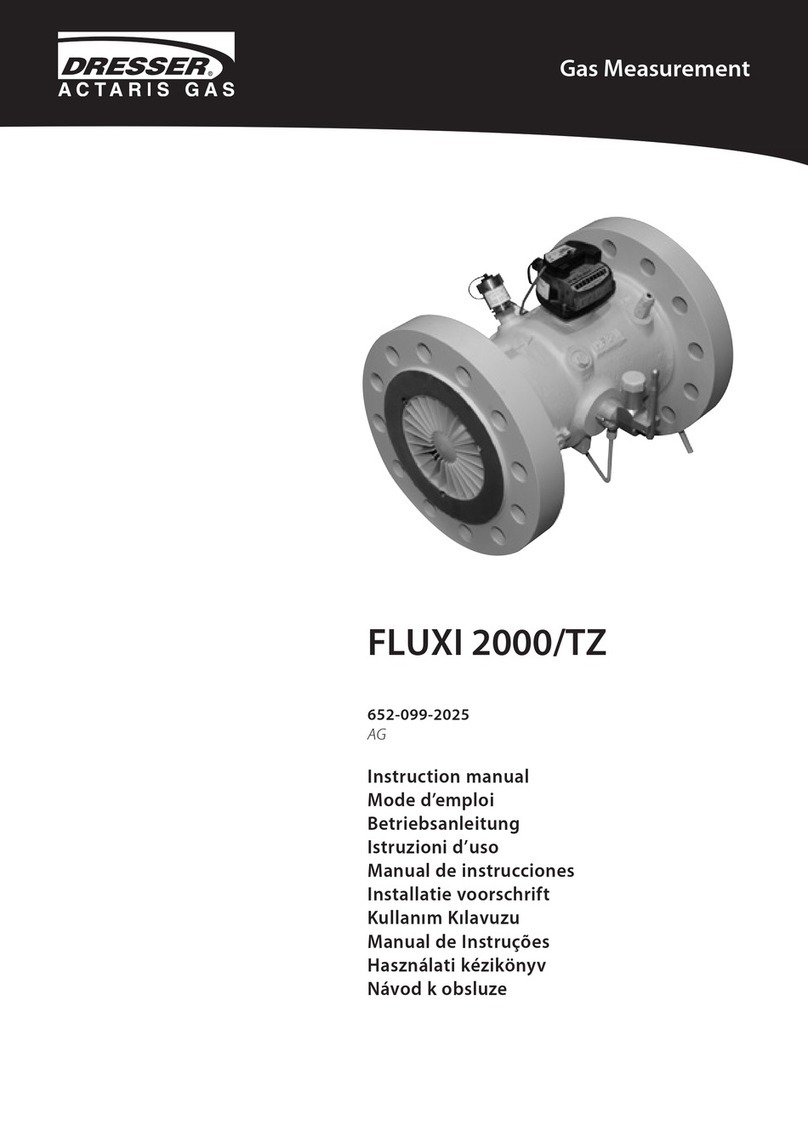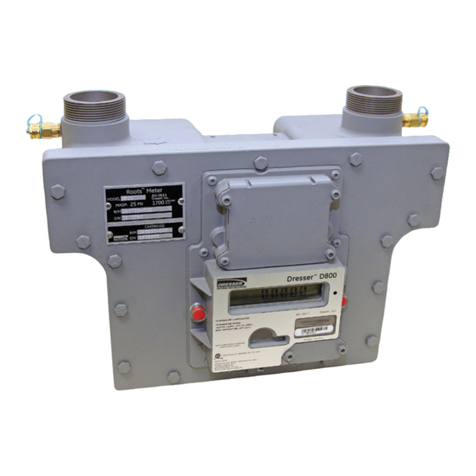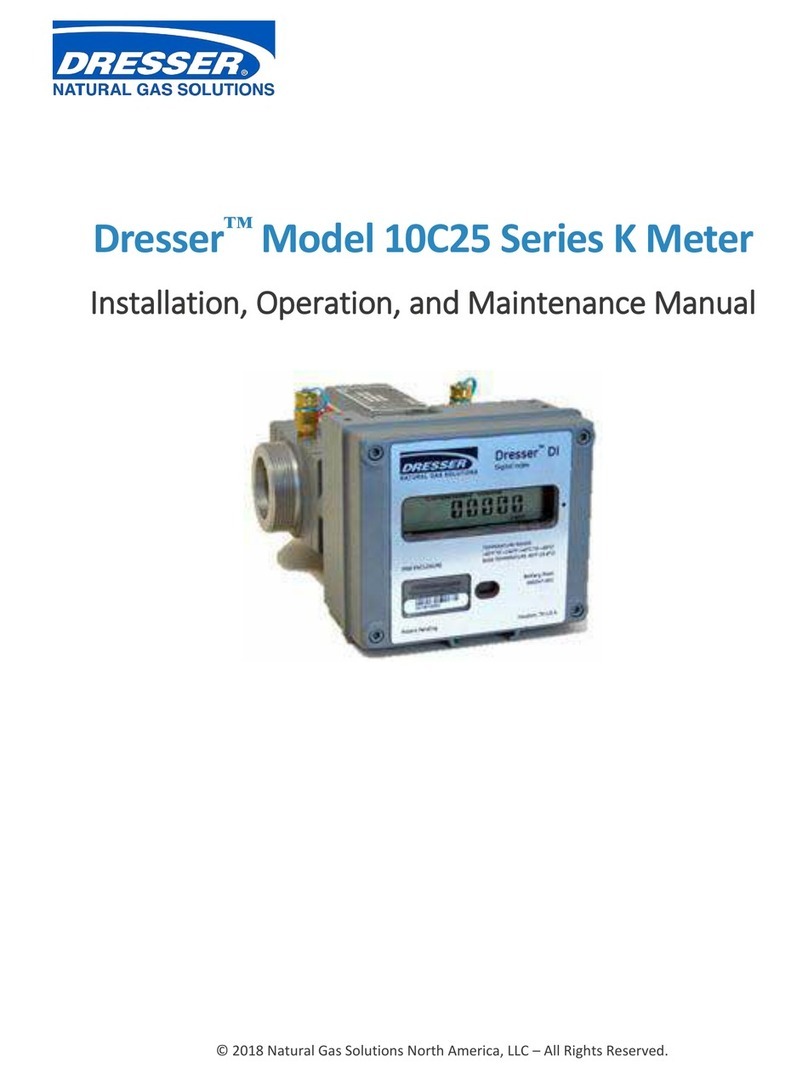
Apressure gauge is used to verify pressure readings.
Astop watch is used to “clock” the meter RPM for
calculating gas flow rate.
CAUTION: When the meter is on line pressure, follow applica-
ble safety rules and wear appropriate protective apparatus.
1. Install the pressure differential indicating device into
the meter inlet and outlet differential taps. Install a
pressure gauge or other pressure standard on the inlet
side of the meter if not a component of the test
equipment.
2. Adjust the meter bypass and the meter inlet valves
until the meter is operating at a predetermined or
selected flow rate in the lower capacity range, or
approximately 25 percent of meter rated capacity.
Let the flow rate stabilize.
3. Time or “clock” the passage of a predetermined volume
of gas as registered on the odometer or instrument to
determine the Index or Flow Rate in Actual Cubic Feet
per Hour (or m3/h):
Index Rate = Cubic Feet x 3600
Test Time (sec)
Convertthe calculated flow rate to a percentage of meter
rated capacity:
%Meter Capacity = Index Rate
Meter Base Rating
4. Recordthe pressuredifferential, line pressure, and gas
specific gravity. Repeat the test to obtain an accurate
average reading.
NOTE: At the time of meter start-up in a new installation,
repeat Steps 2-3 at a minimum of three different flow
rates, each between 25% and 100% of meter capacity.
The original base line curve should be drawn using
data at a constant pressure for all three tests.
5. Remove the differential test equipment and pressure
standard.
6. If the pressuredifferential is within acceptable limits,
return the meter to full service. If the pressure
differential is higher than recommended, remove the
meter for inspection and service. For Factoryassistance
regarding meter inspection and/or repair, please call the
Product Services Department, your Customer Service
Representative, local Sales Representative, or Distributor
and request a Return Material Authorization (RMA).
Proving Operations
Conventional scanning methods may be used with the 5C15
and 8C15 index in meter proving. The standard index for
these meters is a circular (dial) index similar to that found
on residential diaphragm meters. The preferred method is to
focus a photocell or scanner on the “Half Foot” test hand.
Each revolution represents 1/2 cubic foot of volume.
Adifferential pressure test consists of a series of
differential pressure readings taken across the meter at
several gas flow rates within the meter’s capacity range.
Ideally, testing should be performed when the meter is
first installed and under the actual conditions of gas line
pressure and specific gravity that will exist in service.
Multiple curves may be necessary for meters under varying
pressure conditions.
When less than 15 PSIG (100kPa Gauge), the meter
differential can, for all practical purposes, be compared
directly with Factory curves or specific meter test results.
The factory Test Data Sheet lists actual meter test results
of accuracy and differential obtained from a bell or piston
prover test on air at atmospheric pressure. Published data
is representative of typical product production.
Establishing Base Line Curves -Developing an original
differential or baseline curve is recommended at the time
of meter initial installation. At least three (3) test points
are required at gas flow rates from 25% to 100% of meter
capacity.Plot the points on a graph and then connect the
points to form a curve. This provides an accurate baseline
for comparison to later tests.
The gas line pressure, specific gravity of the gas, and line
temperature should also be recorded. If the application is
under varying pressure conditions, plot multiple curves for
various pressure ranges (i.e. 5,10 and 15 psig). An increase
in flow rate, line pressure or specific gravity will cause an
increase in the differential.
After developing a base-line curve, meter condition and
performance can be checked periodically by running a
similar differential rate test at a single selected point.
This does not give the overall characteristics for the
meter, but does provide a quick reference check.
Differentials taken at varying flow rates are needed to
give an overall picture.
If the differential pressure increases by more than
50 percent of the original value, inspect the meter for
causes of increased resistance. Principal causes are
binding of impellers, wornbearings, contaminates such
as dirt or valve grease in the meter chamber.
Test Procedure - the test is performed using a ROOTS®
Smart manometer, or other differential pressure test
equipment with an indicating scale range of about 0.9”
(150mm) of water column. The testing device should have
inlet, outlet, and bypass valving, and must be pressure
rated for the maximum metering pressure for the test.
Pressure lines should be connected to the 1/4’ meter inlet
and outlet pressure taps located on the meter
body just above and below the meter nameplate.
(Test plugs can be permanently installed in the pressure
taps to facilitate testing.)
6

































